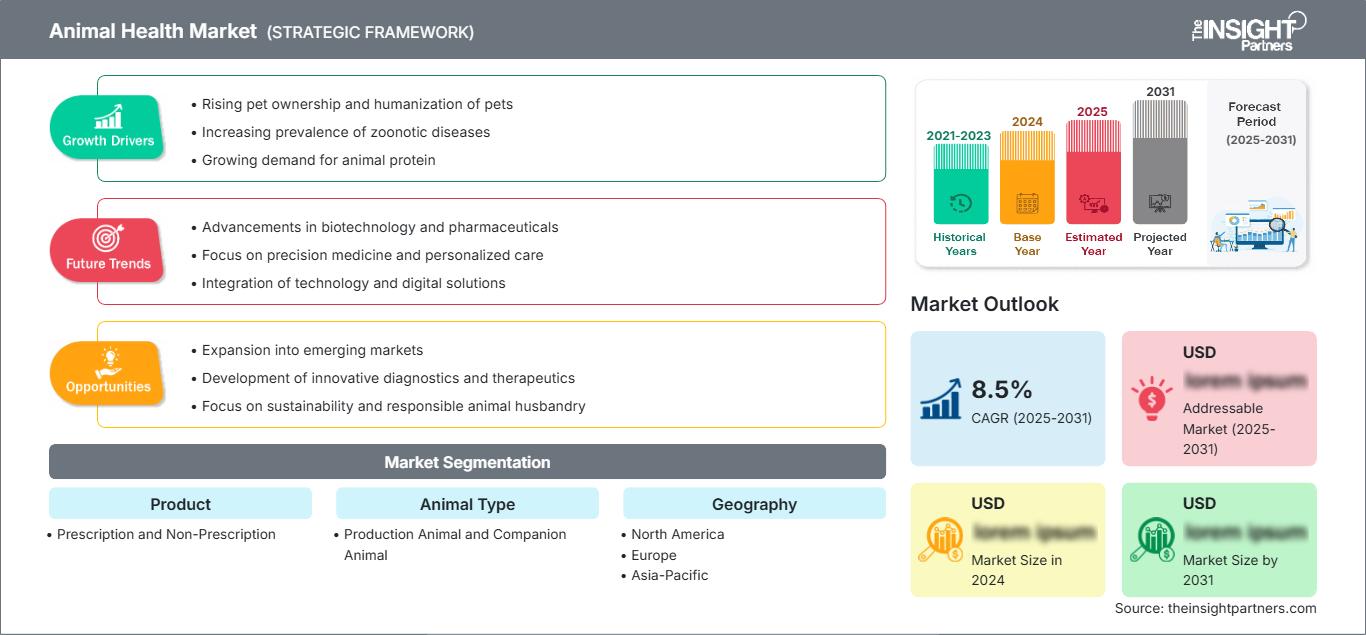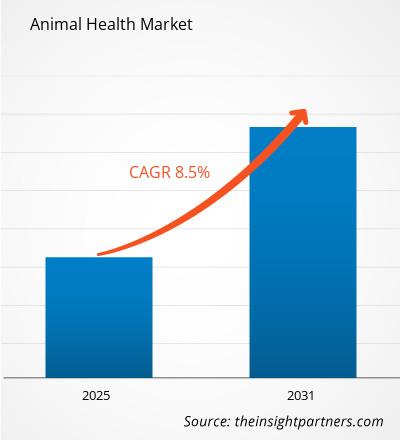Le marché de la santé animale devrait atteindre 144,15 milliards de dollars américains d'ici 2031. Il devrait enregistrer un TCAC de 6,8 % entre 2025 et 2031.
Ce rapport est divisé en deux sections : Produit (sur ordonnance et en vente libre) et Type d'animal (animaux de production et animaux de compagnie). L'analyse mondiale est ventilée par région et par principaux pays. L'évaluation du marché est présentée en dollars américains pour l'analyse segmentaire ci-dessus.
Objectif du rapport
Le rapport sur le marché de la santé animale, réalisé par The Insight Partners, vise à décrire le paysage actuel et la croissance future, les principaux facteurs de croissance, les défis et les opportunités. Cela permettra d'éclairer divers acteurs du marché, tels que :
- Fournisseurs de technologies/Fabricants : Pour comprendre l'évolution de la dynamique du marché et identifier les opportunités de croissance potentielles, afin de prendre des décisions stratégiques éclairées.
- Investisseurs : Pour réaliser une analyse approfondie des tendances concernant le taux de croissance du marché, les projections financières et les opportunités tout au long de la chaîne de valeur.
- Organismes de réglementation : Pour encadrer les politiques et les activités du marché afin de minimiser les abus, préserver la confiance des investisseurs et garantir l'intégrité et la stabilité du marché.
Segmentation du marché de la santé animale : Produits
- Sur ordonnance et sans ordonnance
Type d'animal
- Animaux de production et animaux de compagnie
Vous bénéficierez d’une personnalisation sur n’importe quel rapport - gratuitement - y compris des parties de ce rapport, ou une analyse au niveau du pays, un pack de données Excel, ainsi que de profiter d’offres exceptionnelles et de réductions pour les start-ups et les universités
Marché de la santé animale: Perspectives stratégiques

-
Obtenez les principales tendances clés du marché de ce rapport.Cet échantillon GRATUIT comprendra une analyse de données, allant des tendances du marché aux estimations et prévisions.
Facteurs de croissance du marché de la santé animale
- Augmentation du nombre d'animaux de compagnie et humanisation de ces derniers : De plus en plus de personnes adoptent des animaux, les considèrent comme des membres de la famille et investissent dans leurs soins de santé.
- Prévalence croissante des zoonoses : Les maladies transmissibles entre les animaux et les humains sont en hausse, ce qui accroît le besoin de mesures de santé animale.
- Demande croissante de protéines animales : La population mondiale augmente, entraînant une demande accrue de viande et de produits laitiers et, par conséquent, un besoin accru d'élevages sains.
Tendances futures du marché de la santé animale
- Progrès en biotechnologie et en pharmacie : Les nouvelles technologies permettent de développer des vaccins, des diagnostics et des traitements plus efficaces contre les maladies animales.
- Priorité à la médecine de précision et aux soins personnalisés : Adapter les traitements à chaque animal en fonction de ses besoins spécifiques et de son patrimoine génétique.
- Intégration des technologies et des solutions numériques : Utilisation de la technologie pour des applications telles que la surveillance à distance, la télémédecine et l’analyse des données afin d’améliorer les soins aux animaux.
Opportunités du marché de la santé animale
- Expansion sur les marchés émergents : De nombreux pays en développement connaissent une croissance de leur population animale et une demande accrue de produits et services de santé animale.
- Développement de diagnostics et de traitements innovants : Création d’outils nouveaux et améliorés pour le diagnostic et le traitement des maladies animales.
- Priorité à la durabilité et à un élevage responsable : Promotion du bien-être animal, réduction de l’impact environnemental de l’élevage et garantie d’un usage responsable des antibiotiques.
Marché de la santé animale
Les analystes de The Insight Partners ont analysé en détail les tendances régionales et les facteurs influençant le marché de la santé animale tout au long de la période prévisionnelle. Cette section aborde également les segments et la répartition géographique du marché de la gestion des troubles du rythme cardiaque en Amérique du Nord, en Europe, en Asie-Pacifique, au Moyen-Orient et en Afrique, ainsi qu'en Amérique du Sud et centrale.
Portée du rapport sur le marché de la santé animale
| Attribut de rapport | Détails |
|---|---|
| Taille du marché en 2024 | US$ XX Billion |
| Taille du marché par 2031 | US$ 144.15 Billion |
| TCAC mondial (2025 - 2031) | 6.8% |
| Données historiques | 2021-2023 |
| Période de prévision | 2025-2031 |
| Segments couverts |
By Produit
|
| Régions et pays couverts |
Amérique du Nord
|
| Leaders du marché et profils d'entreprises clés |
|
Densité des acteurs du marché de la santé animale : comprendre son impact sur la dynamique commerciale
Le marché de la santé animale connaît une croissance rapide, portée par une demande croissante des utilisateurs finaux, elle-même alimentée par l'évolution des préférences des consommateurs, les progrès technologiques et une meilleure connaissance des avantages des produits. Face à cette demande grandissante, les entreprises élargissent leur offre, innovent pour répondre aux besoins des consommateurs et tirent parti des tendances émergentes, ce qui stimule davantage la croissance du marché.

- Obtenez le Marché de la santé animale Aperçu des principaux acteurs clés
Points clés de vente
- Couverture exhaustive : Ce rapport analyse en détail les produits, services, types et utilisateurs finaux du marché de la santé animale, offrant ainsi une vision globale.
- Analyse d'experts : Ce rapport repose sur une connaissance approfondie du secteur et des analystes.
- Informations actualisées : Grâce à sa couverture des informations et tendances les plus récentes, ce rapport garantit la pertinence de vos analyses.
- Options de personnalisation : Ce rapport peut être personnalisé pour répondre aux besoins spécifiques de vos clients et s'adapter parfaitement à leurs stratégies commerciales.
Ce rapport d'étude de marché sur la santé animale peut donc vous aider à décrypter et comprendre le contexte sectoriel et les perspectives de croissance. Malgré quelques points à améliorer, les avantages de ce rapport l'emportent généralement sur les inconvénients.
- Analyse historique (2 ans), année de base, prévision (7 ans) avec TCAC
- Analyse PEST et SWOT
- Taille du marché Valeur / Volume - Mondial, Régional, Pays
- Industrie et paysage concurrentiel
- Ensemble de données Excel
Rapports récents
Rapports connexes
Témoignages
Raison d'acheter
- Prise de décision éclairée
- Compréhension de la dynamique du marché
- Analyse concurrentielle
- Connaissances clients
- Prévisions de marché
- Atténuation des risques
- Planification stratégique
- Justification des investissements
- Identification des marchés émergents
- Amélioration des stratégies marketing
- Amélioration de l'efficacité opérationnelle
- Alignement sur les tendances réglementaires






















 Obtenez un échantillon gratuit pour - Marché de la santé animale
Obtenez un échantillon gratuit pour - Marché de la santé animale